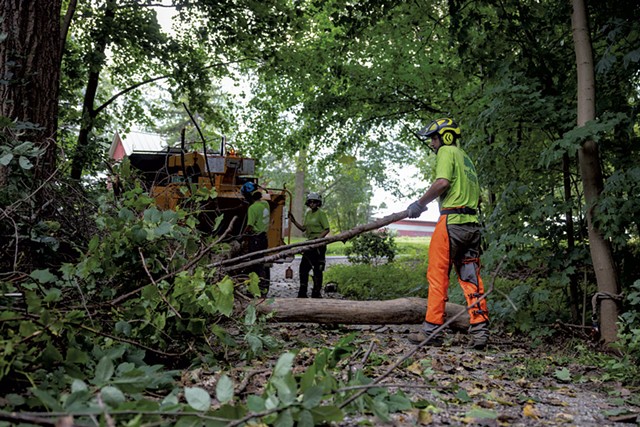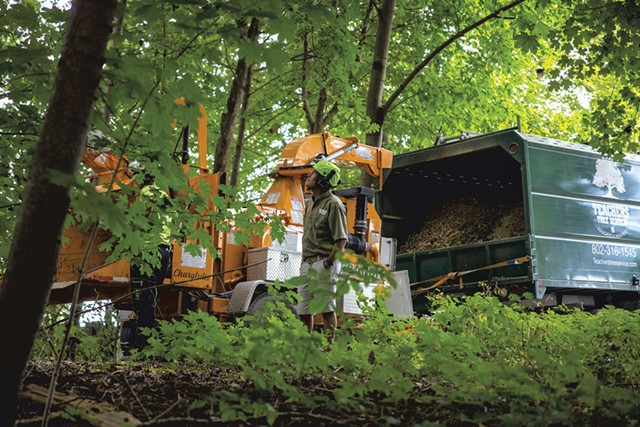- James Buck
- Teachers Tree Service owner Greg Ranallo
Greg Ranallo rarely gets to climb trees anymore. At age 62, after running his tree care business for two decades, he mostly works behind a desk doing payroll and paperwork, not in the field with his crew.
On a recent day, though, he hoisted himself about 45 feet into the canopy of a giant pin oak tree in Charlotte to help his arborists with a major pruning job. The tree — likely close to 70 years old, Ranallo guessed — had grown cluttered with leafless branches, creating a safety risk if they fell.
“It just hadn’t been pruned in 30 years,” said Ranallo, owner of Teachers Tree Service in Shelburne. “It was full of deadwood.”
Ranallo wore a lime-green helmet and a forest-green Teachers T-shirt as he dangled between branches. He balanced on a limb, one foot in front of the other, reaching with a long polesaw to fell the oak’s outer boughs.
“He’s in his happy place,” Eric Reindel, one of Ranallo’s employees, said as he collected the fallen debris and fed it into a wood chipper.
Ranallo is like a tree doctor and teacher all in one. The former high school educator — yes, that’s where the name Teachers comes from — administers care and treatment to keep deciduous and coniferous specimens strong. For property owners grappling with everything from overgrown shrubs to the threat of invasive pests, particularly the dreaded emerald ash borer, Teachers offers information and an honest appraisal of tree health with the sole goal of helping trees live their best lives.
Saturated soils from this summer’s heavy rains have made trees vulnerable to toppling in strong winds, and Teachers had to remove a bunch of fallen white pines that were too large to replant. The crew also assists with construction projects that encroach on adjacent trees. For a golf club that wanted to add a parking lot but keep a giant elm on the site, the team applied a growth inhibitor to temper the tree’s size while letting the foliage flourish.
To address compacted soil, which inhibits beneficial organisms and cuts off water and nutrients for tree roots, Teachers fertilizes with humic acid and biochar. The crew also stems the intrusion of non-native tree and shrub species, which typically require chemical maintenance to survive pests and climate conditions in places they weren’t meant to live.
“We yank out buckthorn and honeysuckle and all that stuff and replant native species to support insects and birds,” Ranallo said. “That’s a growing part of our business.”
But Ranallo often talks himself out of a job when an owner wants to remove a tree that he considers viable and valuable. More than one resident has asked Teachers to take out a whole stand of healthy trees — an expensive order — so they can install solar panels, and he has refused.
“Somebody wanted a lot of oaks cut down in their yard because they wanted the firewood or didn’t like the acorns,” Ranallo said. “I’m not going to do that,” he told the homeowner.
Conversely, he’ll also advise customers to save money on the care or treatment of a tree that he deems too sick or damaged to save.
Ranallo has made it his mission in recent years to educate property owners on the evils of the emerald ash borer and offer solutions. The Asian bug feeds on a tree’s cambium, the layer underneath the bark that allows growth. That’s why the pest is so deadly; it’s nearly invisible until it decimates its host. Ranallo believes that the emerald ash borer will ultimately wipe out huge stands of ash in Green Mountain forests.
At homes, though, residents can take steps toward prevention and treat their ash before or in the early stages of infestation. Otherwise, Ranallo warned, owners will lose significant trees.
“They serve important functions, like providing shade, providing aesthetics,” said Sarah Pears, Teachers’ operations manager. “There’s neighborhoods where most of the street trees are mature ash trees, so to have all those gone in one go would be devastating.”

- James Buck
- Teachers Tree Service crew at a worksite in Shelburne
To treat them, Teachers’ certified technician injects a pesticide called emamectin benzoate into tiny holes in ash trunks using a necklace of small syringes. “It looks like an IV for the tree,” Ranallo said.
Some companies use larger needles inserted into plastic taps that they leave in the trunk after treatment, but Teachers opts for the smallest incision possible, which helps the tree heal.
The toxin travels through the tree bark and kills any insect that eats the tree. The treatment costs $200 to $250 for the average ash tree and lasts for two years. To remove the same tree, Teachers would charge $1,000 or more.
The injected poison will kill other pests that feed on the tree, but studies have found that emamectin benzoate does no harm to birds or other mammals, even those that eat the infected bugs.
“We try to make our treatments for plant health care as targeted and surgical as possible, because we don’t want any impacts on the good things,” Pears said.
Ranallo worries so much about the fate of the state’s ash trees that he has treated some pro bono. One of the largest specimens he has seen in Chittenden County, a white ash with a trunk 53 inches wide in diameter in Charlotte, belongs to a homeowner who couldn’t afford the injections, so Ranallo did the work for free.
On the brighter side, the wet summer created unwelcome conditions for the spongy moth, which burgeoned across Chittenden County neighborhoods last year. The larvae munch on leaves that trees need to photosynthesize sunlight and store energy. “It’s like shutting down solar panels,” Ranallo said.
The moths aggravate people, too: Residents spent last summer dodging moth larvae that dropped from trees onto patios, picnic tables and car windshields. All the rain this year allowed for the growth of fungal pathogens, which infect and kill the larvae, Pears said.
Teachers also uses an injection method to eradicate spongy moth. The company almost never sprays pesticides to treat pests and other tree plagues, Ranallo said: “It’s too general, and it drips and gets on employees and people’s yards.”
Ranallo grew up in Minnetonka, Minn., and began working for a tree service company at age 19. He and a friend then started their own tree company there before Ranallo went back to school for his master’s degree and became a high school teacher of economics, anthropology and world studies.
While raising their two sons, Ranallo and his wife wanted them to have closer access to the woods and opportunities to ski and hike. They looked at a U.S. map and picked Vermont, assuming it had the right conditions. They moved here in 2003 “and never looked back,” Ranallo said.
He started Teachers Tree Service while he was still teaching and hired many fellow educators during their summer breaks. Today, much of Teachers’ team boasts an ecologically based education that informs the hard, hands-on labor done in the field. Pears has a master’s degree from the University of Vermont’s Rubenstein School of Environment and Natural Resources. Four members of the crew are certified arborists.
“If you want to learn about the trees in your yard, call us,” Pears said. “If you just want to take down the trees in your yard, you might not want to call us.”
Ranallo recently learned that his family history has deep roots in trees. His great-grandfather came to the United States from Italy to work as a logger in Wisconsin, he said, and his grandfather was a tree climber who cut down limbs in the Pacific Northwest.
Continuing in that tradition, Ranallo describes himself as an “evangelist” about garden and landscape practices. He never hesitates to offer a tree owner advice or tough love, even if unsolicited and even when he’s off the job.
“After 40 years in the tree business, I notice trees everywhere I go,” Ranallo said. “I can’t help myself.”
m.sevendaysvt.com
https://m.sevendaysvt.com/home-design/teachers-tree-service-schools-homeowners-on-healthy-arboreal-landscapes-39228088














